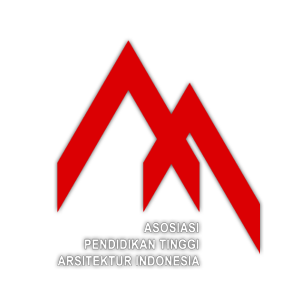Wayfinding dalam Arsitektur
Anjas Ninda Hantari(1*), Ikaputra Ikaputra(2)(1) Universitas Gadjah Mada
(2) Magister Arsitektur, Fakultas Teknik, Universitas Gadjah Mada
(*) Corresponding Author
Abstract
Wayfinding adalah proses menemukan jalan, pengumpulan informasi dan pengambilan keputusan yang digunakan orang untuk mengarahkan diri mereka, bergerak melalui ruang, serta bagaimana orang berpindah dari satu tempat ke tempat lain. Dikarenakan keberadaannya selalu ditemui dalam kehidupan sehari-hari, wayfinding dikenali sebagai proses yang mudah dikarakterisasi dan dipahami. Oleh sebab pentingnya peran wayfinding dalam kehidupan manusia, maka diperlukan pembahasan untuk memahami elemen-elemen serta prinsip-prinsip menerapkan wayfinding. Untuk mengoptimalkan wayfinding telah dilakukan sejumlah penelitian yang mengungkapkan bahwasanya wayfinding bersifat sangat kompleks. Makalah ini berupa literature review yang bertujuan untuk menjelaskan pentingnya wayfinding serta kebutuhan untuk memahaminya dengan benar. Untuk tujuan tersebut makalah ini membahas aspek sejarah wayfinding, definisi wayfinding, studi kasus penerapan wayfinding, prinsip-prinsip, faktor-faktor, karakteristik lingkungan dan tata spasial serta elemen-elemen arsitektur yang menunjang sistem wayfinding.
Keywords
Full Text:
PDFReferences
Abrams, J. B. (2010). Wayfinding in Architecture. University of South Florida.
Alexander Klippel, K.-F. R. (2005). Wayfinding Chrome Maps. University of Melboure.
Allen, G. (1999). Cognitive Abilities in The Service of Wayfinding: a functional approach. Professional Geographer Vol 51 No 4, 554-561.
Anna Charisse Farr, T. K. (2012). Wayfinding: A Simple Concept, a Complex Process. Queensland University of Technology.
Apelt, R. (2008). Wayfinding in The Built Environment. Brisbane: Public Works Queensland.
Barros, A. d., Somasundaraswaran, K., & Wirasinghe, S. (2007). Evaluation of level of service for transfer passengers at airports.
Journal of Air Transport Management Vol 13 Issue 5, 293-298.
Bransford, J., Sherwood, R., Vye, N., & Rieser, J. (1986). Teaching thinking and problem solving: Research foundations. American Psychologist Journal Vol 4 No 10, 1078–1089.
Burke, M., Alizadeh Fard, T., & Vaez Eslami, S. (2016). Urban Form and Wayfinding: Review of Cognitive and Spatial Knowledge for Individuals' Navigation. Australasian Transport Research Forum. Queensland, Australia: http://atrf.info/papers/2016/index.aspx.
Churchill, A., Dada, E., Barros, A. D., & Wirasinghe, S. (2008). Quantifying and Validating Measure of Airport Terminal Wayfinding. Journal od Air Transport Management Vol 14 Issue 3, 151-158.
Farr, Anna, Kleinschmidt, Tristan, Yarlagadda, Prasad, . . . Kerrie. (2012). Wayfinding: A simple concept, a complex process. Journals of Transport Reviews Vol 32 Issue 6, 715-743.
Golledge, R. G. (1999). Looking Back and Looking Forward. Geographical Analysis Vol 31 No 4, The Ohio State University.
Hao, C. C. (2008). Wayfinding in Complex Multi-Story Buildings: A Vision Simulation-Augmented Wayfinding Protocol Study. Sheffied Hallam University.
Huang, S.-Y. T.-S. (2009). Spatial Forms and Signage in Wayfinding DecisionPoints for Hospital Outpatient Service. University of Science and Technology.
Hunter, S. (2010). Spatial Orientation, Environmental Perception and Wayfinding. New York: University at Buffalo, Center for Inclusive Design and Enivronmental Access.
Hunter, S. (2010). Spatial Orientation, Environmental Perceptionand Wayfinding. IDeA Center, University at Buffalo.
Hwang, Y.-R. (n.d.). The Effectiveness of Facility Assembly Devices Concerning The Wayfiding of People With Visual Impairments. National Yunlin University of Science & Technology.
J., M. (2000). Wayfinding is not signage, but there's more. Geo-Mediatechniques, Technical University Vienna, Austria Rakkolainen.
Lawton. (2010). Making Space for Nature. England: Thomson environmental consultants.
Montello, D. R. (2005). Navigation. Cambridge: Cambridge: Cambridge University Press.
Mustikawati, Y. e. (2018). Wayfinding Beuond Signage: Rethinking The Role of Spatial Objects and Object Relations. University of Indonesia.
O'Neill, M. J. (1991). Effects of Signage and Floor Plan Configuration on Wayfinding Accuracy. Journal of Environment and Behavior Vol 23 Issue 5.
Peponis, Zimring, & Y, C. (1990). Finding the building in wayfinding. Journal of Environment and Behavior Vol 22 Issue 5, 555-590.
R., P. (1984). Wayfinding in Architecture. New York: Van Nostrand Reinhold Company.
Reginald Golledge, R. D. (2000). Cognitive Maps, Spatial Abilities, and Human Wayfinding. Study Review.
Sevinc, Z., & Bozkurt, E. (2015). Wayfinding behaviors in a healthcare environment: a case study analysis of individual differences. Gazi University Journal of Science Part B: Art, Humanities, Design and Planning Vol 3 Issue 3, 37-45.
Sima Vaez, M. B. (2016). Urban Form and Wayfinding: Review of Cognitive and Spatial Knowledge for Individuals Navigation. Griffith University.
Spencer, C., Blades, M., & Morsley, K. (1989). The Child in the Physical Environment: The Development pf Spatial Knowledge and Cognition. Chichester: John Wiley and Sons.
Staff, G. P. (tanpa tahun). Basic of Wayfinding. Diakses dari https://graphicproducts.com/infographics/basics-of-wayfinding pada tanggal 30 November 2019 pukul 12.30 WIB.
Venturi, R., & Brown, D. S. (2004). Architecture as Signs and Systems for a Mannerist Time. Harvard University Press.
Zeynep, S. &. (2015). Wayfinding Behaviors In A Healthcare Environment: A Case Study Analysis of Individual Differences. Journal of Science PartB: Art, Humanities, design and Planning, 3745.
Article Metrics
Abstract view(s): 3148 time(s)PDF: 2564 time(s)
Refbacks
- There are currently no refbacks.









